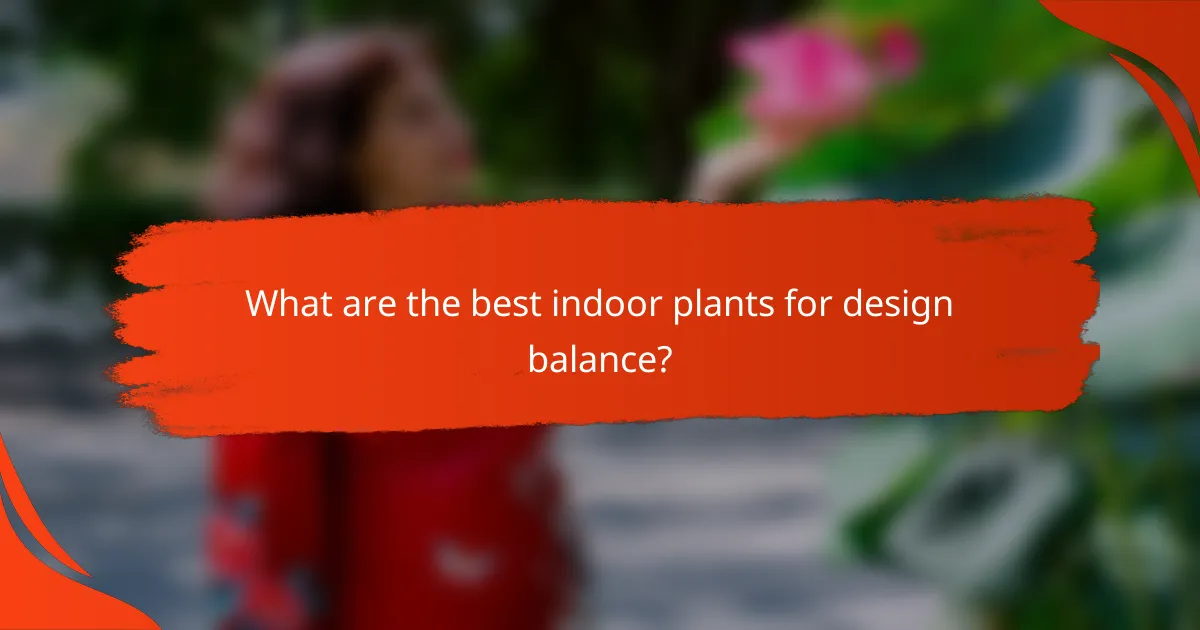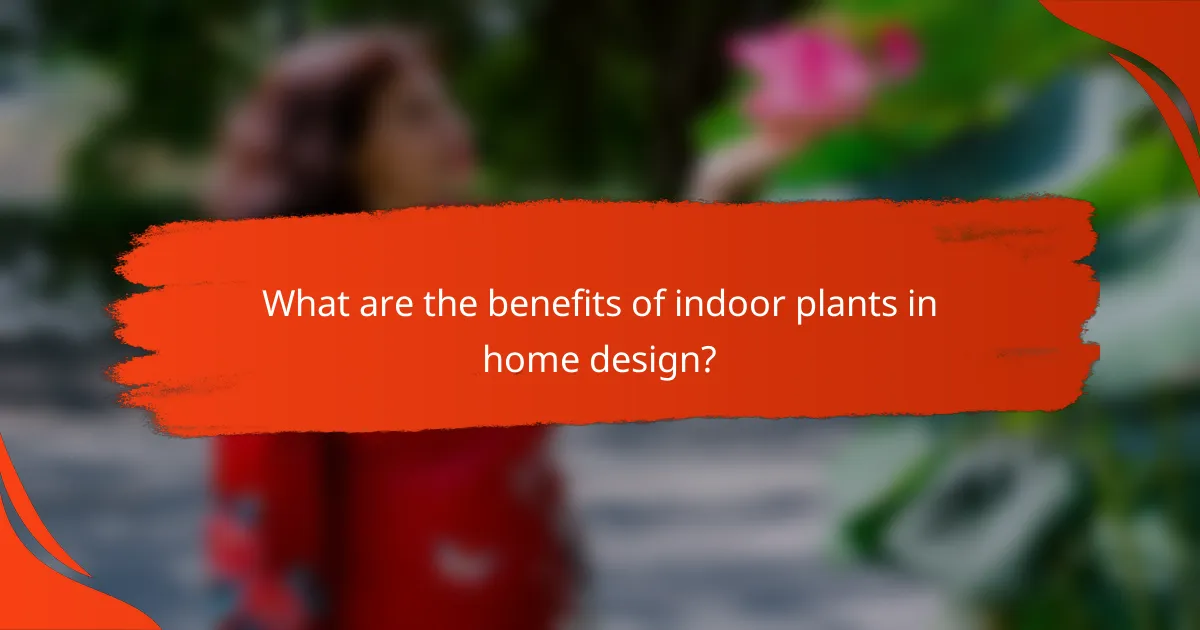Indoor plants can transform a space by enhancing its aesthetic appeal and creating a harmonious environment. By utilizing arrangement techniques such as layering and height variation, you can achieve impactful design that balances visual interest and plant health. Selecting complementary plants and the right containers further elevates the overall look, making your indoor garden both beautiful and functional.

How to visually arrange indoor plants for aesthetic impact?
To achieve aesthetic impact with indoor plants, focus on arrangement techniques that enhance visual appeal and create a harmonious environment. Consider layering, color contrast, height variation, focal points, and the use of stands to elevate your design.
Layering plants for depth
Layering plants involves placing them at different levels to create depth and dimension in your arrangement. Use taller plants in the back and shorter ones in the front to ensure visibility and balance. This technique can make a space feel more dynamic and inviting.
For example, a tall snake plant can serve as a backdrop, while smaller ferns or succulents can fill in the foreground. Aim for a mix of textures and leaf shapes to enhance visual interest.
Using color contrast effectively
Effective use of color contrast can significantly enhance the visual impact of your indoor plants. Choose plants with varying leaf colors, such as deep greens paired with lighter variegated varieties or colorful flowers, to create striking combinations.
Consider using a color wheel to identify complementary colors. For instance, pairing a red-leafed plant with a green one can create a vibrant focal point that draws the eye.
Incorporating varying heights
Incorporating varying heights in your plant arrangement adds visual interest and prevents monotony. Use a mix of tall, medium, and short plants to create layers that guide the viewer’s eye throughout the display.
For instance, place a tall palm next to medium-sized pothos and smaller cacti. This variation not only enhances the aesthetic but also allows each plant to shine in its own right.
Creating focal points with statement plants
Creating focal points with statement plants can anchor your arrangement and draw attention. Choose one or two standout plants, such as a large monstera or a flowering orchid, to serve as the centerpiece of your design.
Position these statement plants strategically, ensuring they are easily visible from multiple angles. This approach can make your indoor space feel more curated and intentional.
Utilizing plant stands and shelves
Utilizing plant stands and shelves can elevate your plants, both literally and figuratively. Stands can create height variation and help smaller plants stand out, while shelves can maximize vertical space in smaller areas.
Consider using tiered plant stands to showcase a variety of plants at different levels. This not only adds depth but also allows for better light exposure for each plant, promoting healthier growth.

What are the best indoor plants for design balance?
The best indoor plants for design balance include those that complement each other in height, structure, and visual appeal. Selecting a variety of plants like the Fiddle Leaf Fig, Snake Plant, Pothos, Peace Lily, and ZZ Plant can create a harmonious and aesthetically pleasing indoor environment.
Fiddle Leaf Fig for height
The Fiddle Leaf Fig is renowned for its tall, dramatic presence, making it an excellent choice for adding verticality to your space. This plant can grow several feet tall, providing a striking focal point in any room.
When positioning a Fiddle Leaf Fig, consider placing it near a window where it can receive bright, indirect light. This will help maintain its lush foliage and overall health.
Snake Plant for structure
The Snake Plant, with its upright leaves and architectural form, adds a sense of structure to your indoor arrangement. Its sword-like leaves can reach up to 3 feet in height, creating a bold statement without taking up much floor space.
This plant is also highly adaptable, thriving in low light and requiring minimal watering. Position it in corners or alongside furniture to enhance the overall design without overwhelming the space.
Pothos for trailing effect
Pothos plants are perfect for creating a trailing effect, which adds depth and movement to your indoor design. Their long vines can cascade from shelves, hanging planters, or window sills, softening hard edges in the room.
These plants are easy to care for and can thrive in various lighting conditions. Consider using them in a macramé hanger or on a bookshelf to draw the eye upward and create visual interest.
Peace Lily for softness
The Peace Lily introduces a touch of softness and elegance with its lush green leaves and delicate white blooms. This plant not only enhances aesthetic balance but also purifies the air, making it a beneficial addition to your home.
Place Peace Lilies in medium to low light areas, and keep the soil consistently moist. Their graceful appearance can help soften the look of more rigid plants in your arrangement.
ZZ Plant for low maintenance
The ZZ Plant is ideal for those seeking a low-maintenance option that still contributes to design balance. Its glossy, dark green leaves provide a striking contrast to lighter foliage and can thrive in low light conditions.
This plant requires infrequent watering, making it perfect for busy individuals. Position the ZZ Plant in a spot where it can be admired, but don’t worry about constant upkeep, as it is quite resilient.

How to choose the right pots and containers?
Choosing the right pots and containers is essential for the health of your indoor plants and the overall aesthetic of your space. Consider factors such as material, size, color, and drainage to ensure both functionality and visual appeal.
Material selection for durability
Selecting durable materials for pots and containers can significantly affect their lifespan and maintenance. Common materials include ceramic, plastic, metal, and terracotta, each offering different benefits. For instance, ceramic pots are sturdy and often come with decorative finishes, while plastic pots are lightweight and resistant to breakage.
Consider your indoor environment when choosing materials; for humid areas, breathable materials like terracotta can prevent root rot, while metal pots may require protective liners to avoid rusting.
Size considerations for plant growth
The size of the pot is crucial for the healthy growth of your plants. A pot that is too small can restrict root development, while an excessively large pot may retain too much moisture. Generally, a pot should be 1-2 inches wider in diameter than the plant’s root ball.
When repotting, aim for a gradual increase in size to avoid shocking the plant. For larger plants, consider pots that are at least 10-12 inches in diameter to provide adequate space for growth.
Color choices to match decor
Color plays a significant role in how pots and containers complement your interior design. Neutral colors like white, beige, or gray can blend seamlessly with various decor styles, while vibrant colors can serve as eye-catching focal points. Consider the existing color palette of your room when selecting pots.
For a cohesive look, choose pots that either match or contrast with your furniture and wall colors. Earthy tones can enhance a natural aesthetic, while bold hues can add a modern touch.
Drainage options for plant health
Proper drainage is vital for maintaining plant health and preventing root rot. Ensure your pots have drainage holes to allow excess water to escape. If using decorative pots without holes, consider placing a smaller pot inside or using a layer of gravel at the bottom.
Additionally, using potting soil that promotes drainage can further enhance plant health. Look for mixes that contain perlite or sand to improve aeration and moisture control.

What are the benefits of indoor plants in home design?
Indoor plants offer numerous benefits in home design, enhancing both aesthetics and functionality. They improve air quality, boost mood, and increase productivity, making spaces more inviting and healthier.
Improved air quality
Indoor plants play a significant role in improving air quality by filtering pollutants and increasing oxygen levels. Common houseplants like spider plants, peace lilies, and snake plants can reduce harmful substances such as formaldehyde and benzene, contributing to a healthier living environment.
To maximize air purification, consider placing one plant per 100 square feet of space. Regularly dusting the leaves and ensuring proper drainage will help maintain their effectiveness and longevity.
Enhanced mood and productivity
Having indoor plants can enhance mood and productivity by creating a calming atmosphere. Studies suggest that exposure to greenery can reduce stress and anxiety, leading to improved focus and creativity. Incorporating plants into workspaces can result in a more pleasant and motivating environment.
To achieve the best results, choose plants that thrive in your specific lighting conditions. For instance, low-light plants such as pothos and ZZ plants are ideal for darker rooms, while succulents and cacti flourish in bright, sunny areas.


